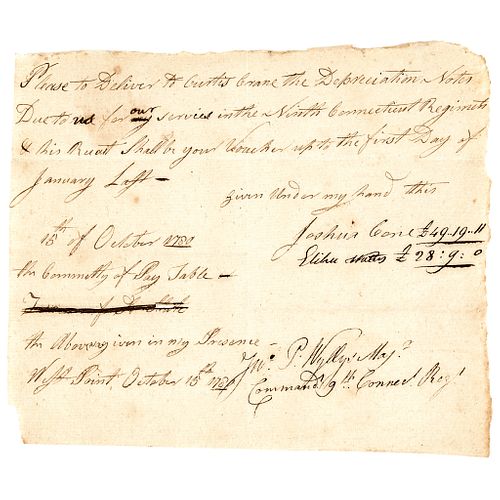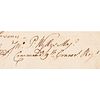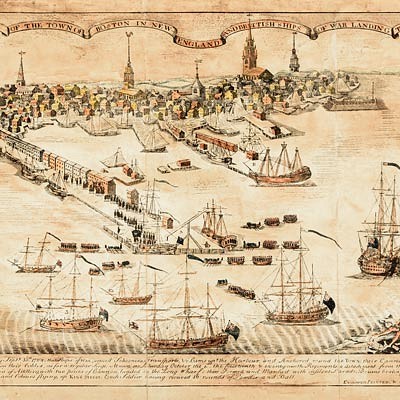1780 Major Commanding the 9th Connect. Regt. West Point Manuscript Pay Document
Lot 148
Categories
Estimate:
$300 - $400
Absentee vs Live bid
Two ways to bid:
- Leave a max absentee bid and the platform will bid on your behalf up to your maximum bid during the live auction.
- Bid live during the auction and your bids will be submitted real-time to the auctioneer.
Bid Increments
| Price | Bid Increment |
|---|---|
| $0 | $10 |
| $200 | $20 |
| $300 | $25 |
| $500 | $50 |
| $1,000 | $100 |
| $2,000 | $200 |
| $3,000 | $250 |
| $5,000 | $500 |
| $10,000 | $1,000 |
| $20,000 | $2,000 |
| $30,000 | $2,500 |
| $50,000 | $5,000 |
| $100,000 | $10,000 |
| $200,000 | $20,000 |
| $300,000 | $25,000 |
| $500,000 | $50,000 |
About Auction
By Early American History Auctions
Mar 20, 2021
Set Reminder
2021-03-20 12:00:00
2021-03-20 12:00:00
America/New_York
Bidsquare
Bidsquare : Autographs-Colonial-Political-Americana
https://www.bidsquare.com/auctions/early-american-history-auctions/autographs-colonial-political-americana-6509
330 Lots of Rare, Historic Autographs, Americana, Civil War Era, George Washington, Abraham Lincoln, Slavery & Black History, Revolutionary War Era, Colonial America, Federal Period, War of 1812, Colonial Currency, Indian Peace Medals & more... Early American History Auctions auctions@earlyamerican.com
330 Lots of Rare, Historic Autographs, Americana, Civil War Era, George Washington, Abraham Lincoln, Slavery & Black History, Revolutionary War Era, Colonial America, Federal Period, War of 1812, Colonial Currency, Indian Peace Medals & more... Early American History Auctions auctions@earlyamerican.com
- Lot Description
American Revolution
1780 Jonathan Palsgrave Wyllys
Major Commanding the 9th Connecticut Regiment
West Point Pay Order
October 15, 1780-Dated, West Point, Manuscript Document Signed, "Jno. P. Wyllys Maj'r Command'g 9th Connect. Regt." Pay Order, Choice Very Fine.
Original Manuscript Document Signed by Major John P. Wyllys, measuring 7" x 5.75", and transcribed, in full:
"Please Deliver to Curtis Crane the Depreciation Notes Due to us for our services in the Ninth Connecticut Regiment & this shall be your voucher up to the first day of January last. -- Given under my hand this 15th October 1780 - the Committ(y) of Pay Table - Joshua Cone" Continuing below, "the above was given in my Presence - West Point, October 15th 1780 - (Signed) Jno. P. Wyllys Maj'r - Command'g 9th Connect. Regt."
Major Jonathan Palsgrave Wyllys was a Continental Army officer who served under George Washington, and was later killed in the Ohio Frontier by Indians in a battle known as "Harmer's Defeat."
During the Northwest Indian War, Harmar's Defeat was a battle which took place in October 1790 near the Ohio and Indiana border. It is also known as The Battle of the Pumpkin Fields, because the steam from the scalped skulls reminded the Indians of squash steaming in the autumn air. During the battle, a group of Indians defeated a force of several hundred miltiamen and a small number regulars commanded by Josiah Harmar.
In 1789, President George Washington wrote to Northwest Territory Governor Arthur St. Clair and asked him to determine if the Wabash and Illinois Indians were inclined for war or peace with the United States. St. Clair was led to believe that the tribes were inclined towards war, and called for a militia force to be assembled at Fort Washington and Vincennes. While a smaller expedition led by Jean Franois Hamtramck marched north from Vincennes, General Harmar left Fort Washington with 320 regulars and 1,133 militiamen. St. Clair wrote to Fort Detroit to assure the British that the expedition was only against Indian tribes, and expressed his confidence that the British would not interfere. Harmar left on 30 September 1790. No time was allotted to train the militia in order to engage the Indians before Winter, when the pack horses would lose their forage and starve. Miami villages near Kekionga were reached on 17 October. Some had been destroyed by deserting Miami, and others were plundered by the Americans. On the 19th, Colonel John Hardin was dispatched with a force of about 200 men to reconnoiter the Indian coalition, led by Miami war chief Little Turtle, and attack the village of Chief Le Gris.
The force was attacked and defeated; 20 regulars and 40 militia men died. On the night of 21 October, Colonel Hardin and Major John P. Wyllys returned with a force of 300 militia and 60 regulars. The Indians fled, and the militia pursued and were scattered. This left the regulars alone and outnumbered. Major Wyllys and 50 regulars were killed, as were over 100 militia. With high casualties from these skirmishes, General Harmar determined that he could no longer mount an offensive.
The approaching Winter further threatened his command as militia deserted and horses died from starvation. The force reached Fort Washington 3 November 1790. The defeat encouraged the Indians in the Northwest Territory to resist the United States. A similar force would be led the next year under Governor St. Clair, and would end in one of the worst defeats by American Indians the United States would ever receive.
A courts martial in 1791 cleared Harmar of any wrong-doing during the campaign which ended at Harmar's Defeat.
Our Auction Contents:
Black History & Slavery: (Lots 1 - 63)
Abraham Lincoln Related: (Lots 64 - 74)
Historic Autographs: (Lots 75 - 235)
Colonial America: (Lots 236 - 261)
Revolutionary War: (Lots 262 - 304)
George Washington Related: (Lots 305 - 306)
Early American Guns & Weapons: (Lots 307 - 318) - Shipping Info
-
Early American provides in-house worldwide shipping. Please contact us directly if you have questions about your specific shipping requirements.
-
- Buyer's Premium



 EUR
EUR CAD
CAD AUD
AUD GBP
GBP MXN
MXN HKD
HKD CNY
CNY MYR
MYR SEK
SEK SGD
SGD CHF
CHF THB
THB













